20-Minute Beef Gochujang Noodles
Savor quick and flavorful Gochujang Noodles made with Beef in under 20 minutes. This easy Korean-inspired dish blends spicy gochujang chili paste, sweet apple, and pantry staples for a satisfying one-bowl meal that’s simple to customize.
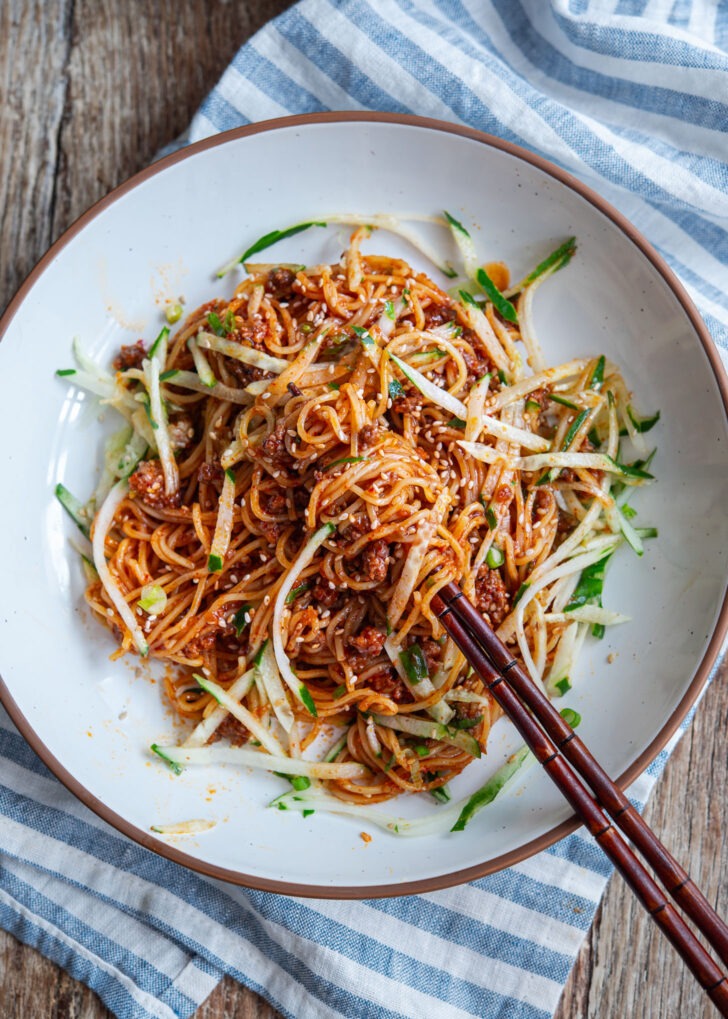
Got a noodle craving? Try the warmth of these Beef Gochujang Noodles, the perfect answer to your hunger pangs.
With leftover ground beef and a fortunate stash of fresh noodles, I whipped up this irresistibly delicious Korean noodles. It’s savory, satisfying, and just the right amount of spicy.
And the best part? This recipe is a canvas, just waiting for your personal touch—customize it with whatever you have on hand.
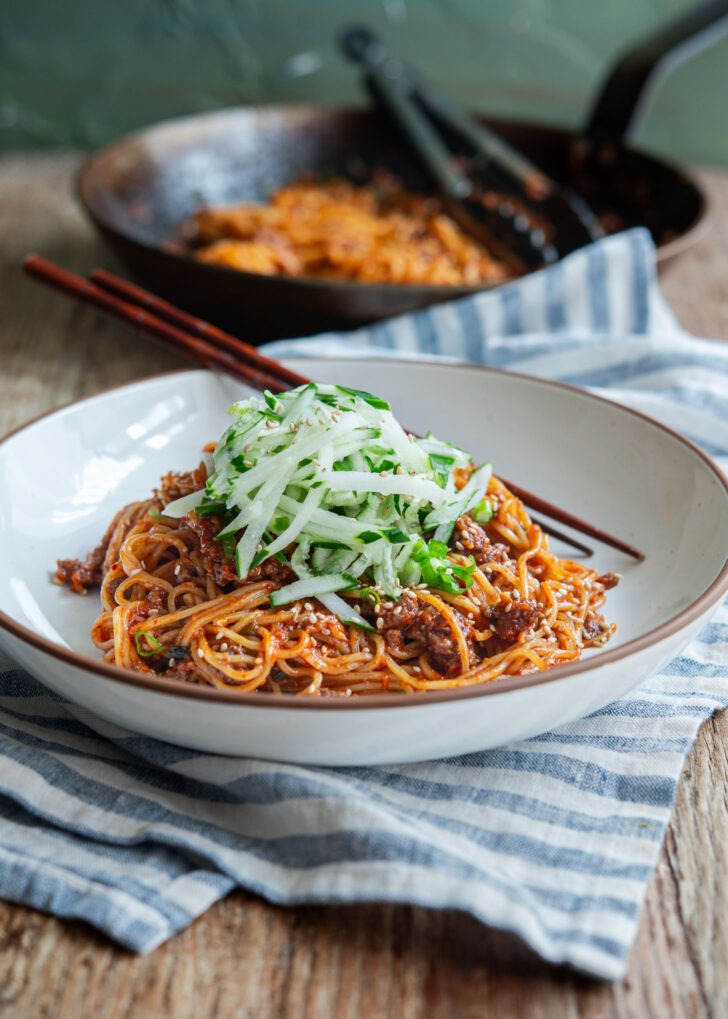
Why You’ll Love This Recipe
Flavorful Sauce Made with Fresh Ingredients
You can’t beat the vibrant, bold flavor that the combination of gochujang, green onions, sweet apple, and a touch of honey creates. Every bite is packed with savory depth, a hint of sweetness, and a spicy kick that gently tingles your tongue.
Nutritionally Well-Balanced One-Bowl Meal
With the addition of ground beef and a fresh cucumber topping, this meal is a complete, nutritionally balanced meal served in one satisfying bowl.
Take a look at my Korean Ground Beef Recipe for another speedy weeknight dinner suggestion!
Adaptability
Tailor this dish to suit your needs by swapping the ground beef for a protein of your choice. Adjust the gochujang to align with your heat tolerance and tweak the seasoning by adding a splash of soy sauce if desired.
Easy to Make
Big flavors don’t require a big time commitment. You’ll have a delicious, enticing meal ready in 20 minutes or less, from start to finish. See my Yaki Udon for another quick recipe.
Key Ingredients and Customization Options
The elements that bring these Gochujang Noodles to life are simple Asian staple ingredients, paired with a variety of customization options to make this dish uniquely your own.
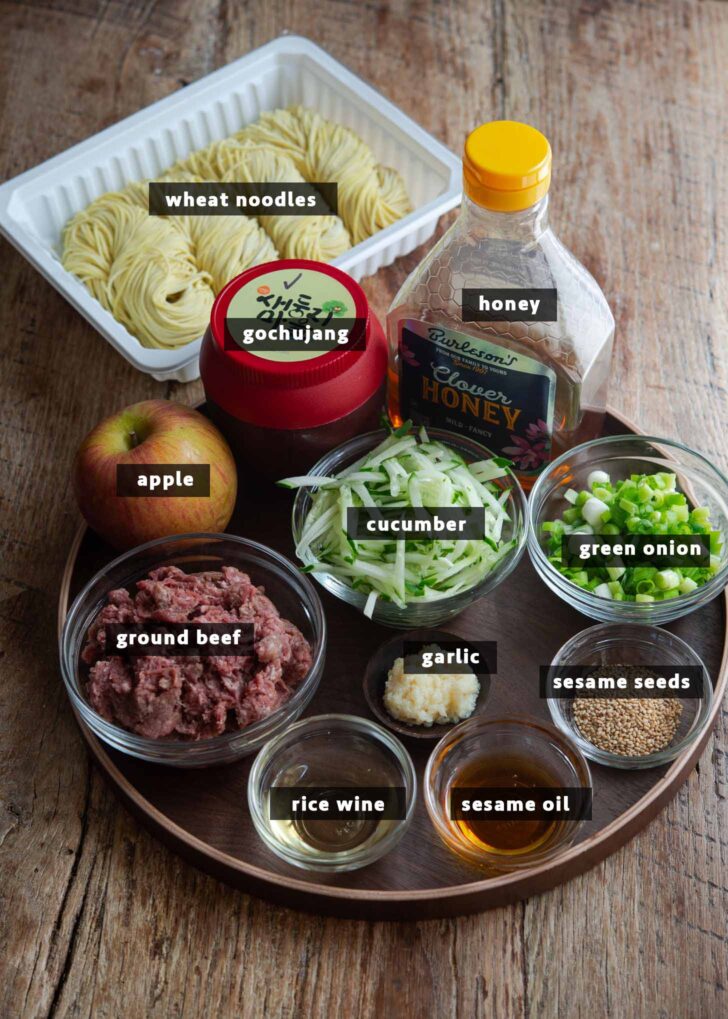
Gochujang
This Korean fermented chili paste is a flavor powerhouse, essential for anyone looking to explore Korean cuisine. It’s crafted from Korean chili flakes, rice or wheat (which varies by brand), and salt, resulting in a spicy base that carries a subtle sweet and tangy undercurrent.
Substitute: Replacing the precise flavor of gochujang is challenging due to its unique combination of fermented depth, sweetness, and spiciness. For the most satisfying results, I strongly advise to use genuine gochujang in your dish. You can typically find it in well-stocked grocery stores, Asian markets, or online.
Noodles
Your choice of noodles is flexible—fresh or dried, they all work. For this recipe, I used fresh ramen noodles, a comforting and familiar option. But Udon noodles, egg noodles (Check my Hong Kong Noodles) , rice noodles, or even spaghetti can effortlessly step in to suit your pantry.
I don’t recommend using thin wheat noodles (somen) for this recipe, as they can break easily while tossing with the sauce. For a great way to use somen noodles, see my bibim guksu recipe.
Note: Before incorporating them into the stir-fry, make sure to cook your chosen noodles in a separate pan according to the package instructions. Note that fresh noodles tend to be heavier than dried noodles, so be mindful to use the right amount to match the serving size you desire.
Beef
For this recipe, I opted for 90% lean ground beef, which adds a satisfying and protein-rich element. Prefer poultry or pork? Both work beautifully when minced, ground, or sliced.
For vegetarian or vegan diets, plant-based proteins can be seamlessly substituted.
Cucumber
This cool, crunchy addition contrasts brilliantly with the dish’s heat, offering a refreshing bite that rounds out the meal. If cucumbers aren’t your favorite, shredded lettuce or other crisp salad vegetables make excellent alternatives.
Apple
A sweet apple, grated directly into the skillet, acts as a natural sweetener, enhancing the sauce’s depth while complementing its spicy notes.
Substitute: For a different yet equally delicious twist, consider a firm Bosc or Asian pear, peeled and grated. If grating isn’t convenient, apple or pineapple juice can fill in with a sweet touch.
Honey
A dollop of honey works wonders to tame the gochujang’s heat, creating a perfectly balanced, sweet-spicy sauce that’s utterly irresistible. Brown sugar makes a straightforward and effective substitute if honey isn’t on hand.
Other Ingredients
Green Onion and Garlic: These aromatic additions infuse the dish with a savory depth that harmonizes with the other vibrant flavors in play.
Sweet Rice Wine (Mirin): Used widely in Korean and Japanese kitchens, Mirin lends a subtle richness to the sauce, elevating it from simple to sumptuous.
- Where to Buy: You can easily find sweet rice wine at well-stocked grocery stores, specialized Asian markets, or conveniently online.
- As a substitute for rice wine in this recipe, consider adding a small splash of rice vinegar. Refer to the recipe card below for details.
Sesame Oil and Sesame Seeds: The final touch, toasted sesame oil and seeds, are sprinkled in at the end, sealing the dish with a nutty fragrance and rich, toasty flavor.
- For the most authentic experience, I recommend Korean sesame oil—it stands a cut above the rest in fragrance and taste.
How to Make Gochujang Noodles: Step-by-Step Instructions
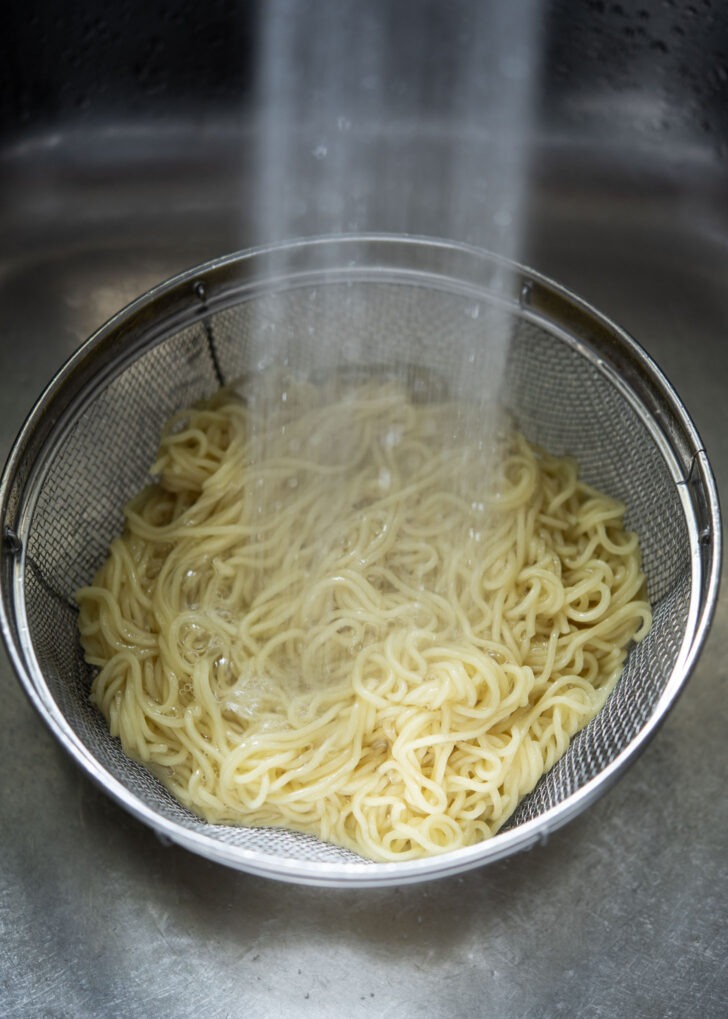
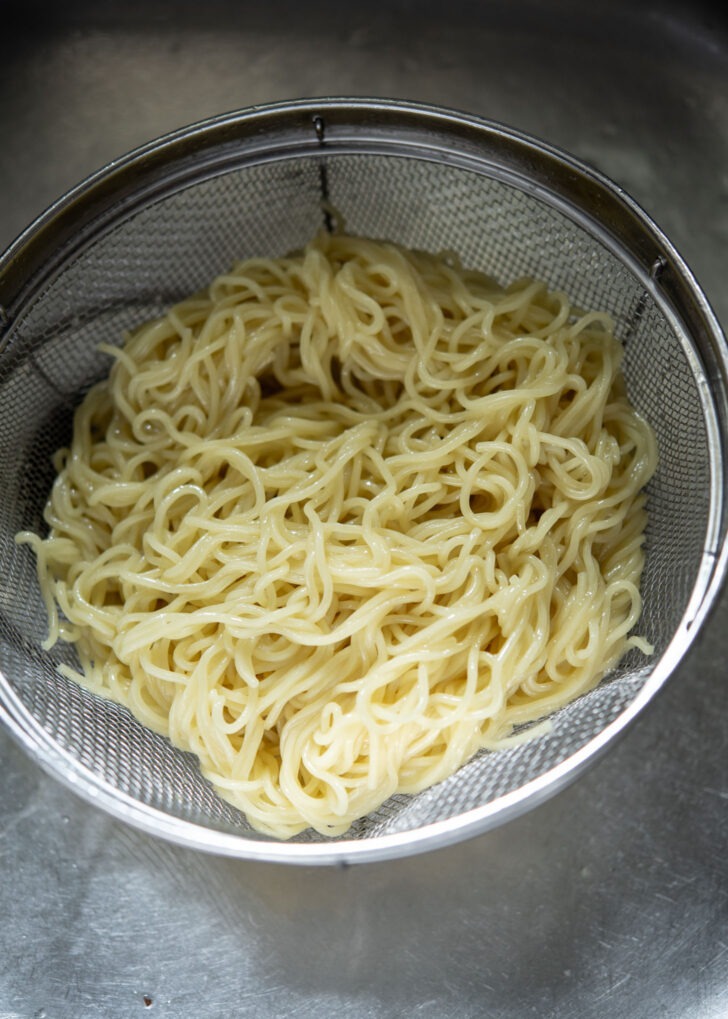
Step 1. Prepare the Noodles
- Cook your choice of noodles according to the package directions. Drain and set aside.
- Note: If using fresh wheat noodles (such as ramen noodles), rinse under water to remove extra starch, and coat with a small amount of oil to prevent sticking.
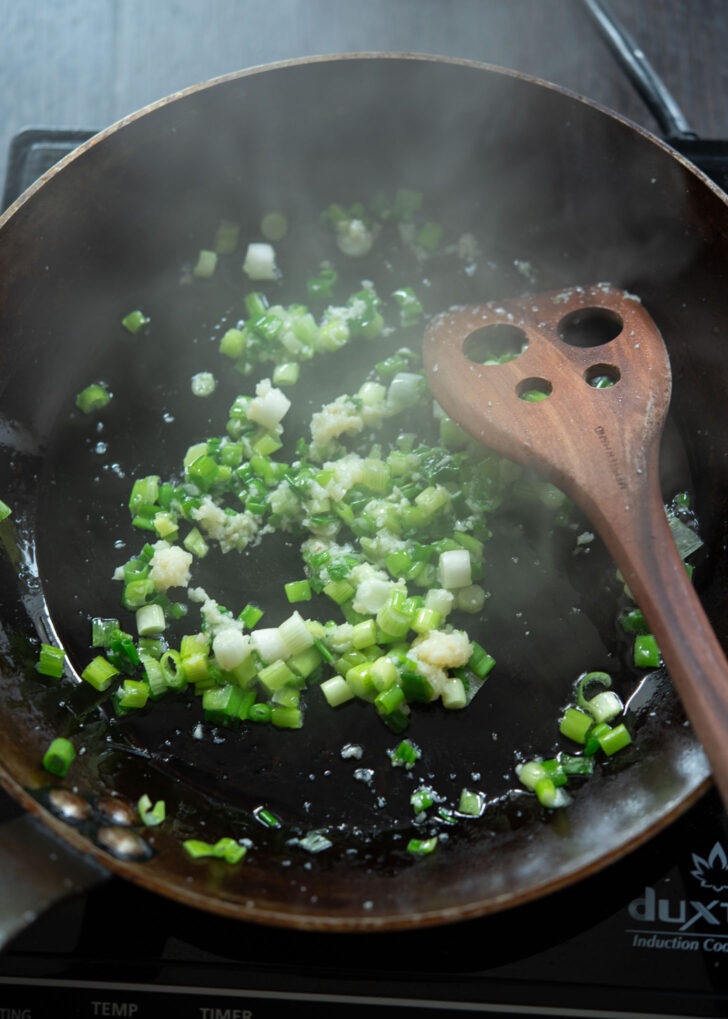
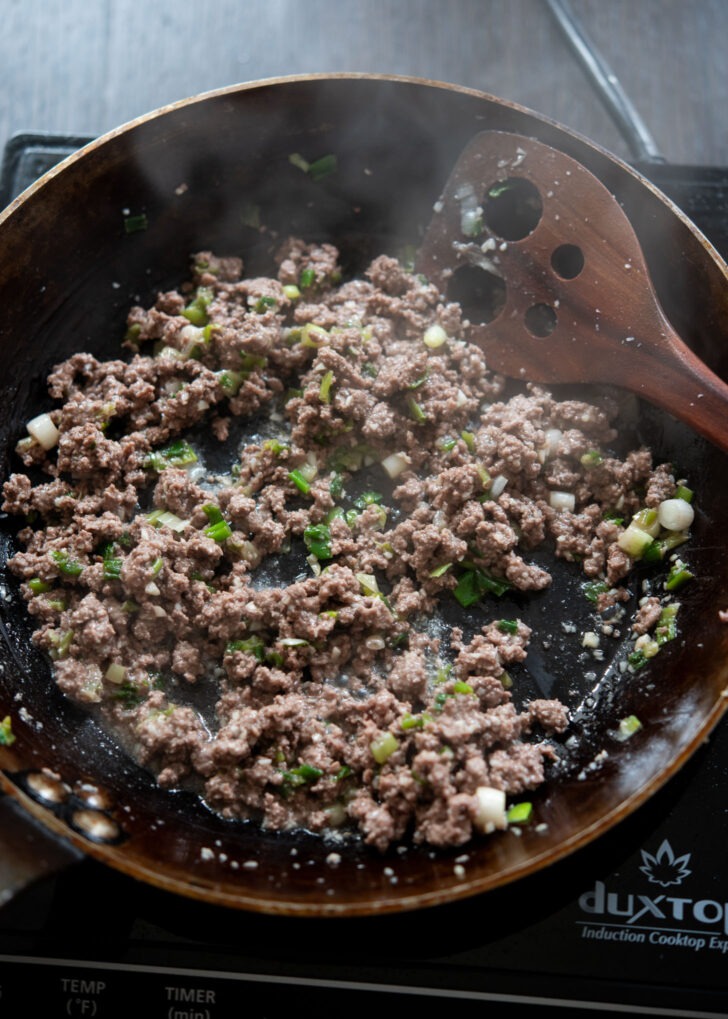
Step 2. Prepare the Beef Mixture
- In a large skillet, heat oil over medium heat. Add green onion and garlic; stir-fry for 30 seconds.
- Add ground beef and cook until no longer pink and cooked through.
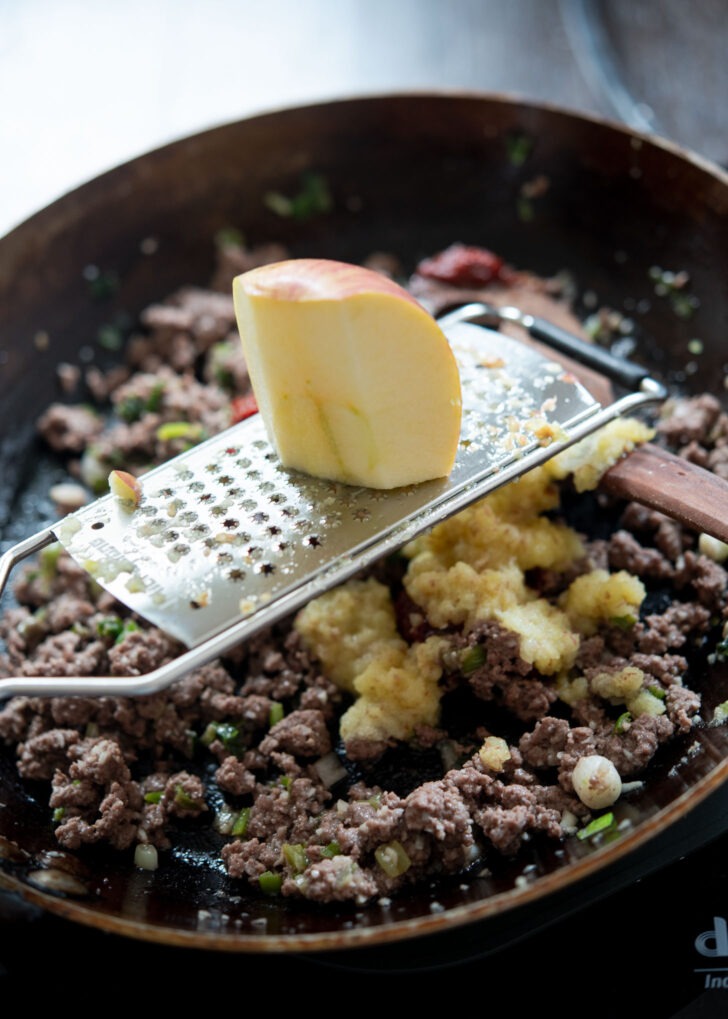
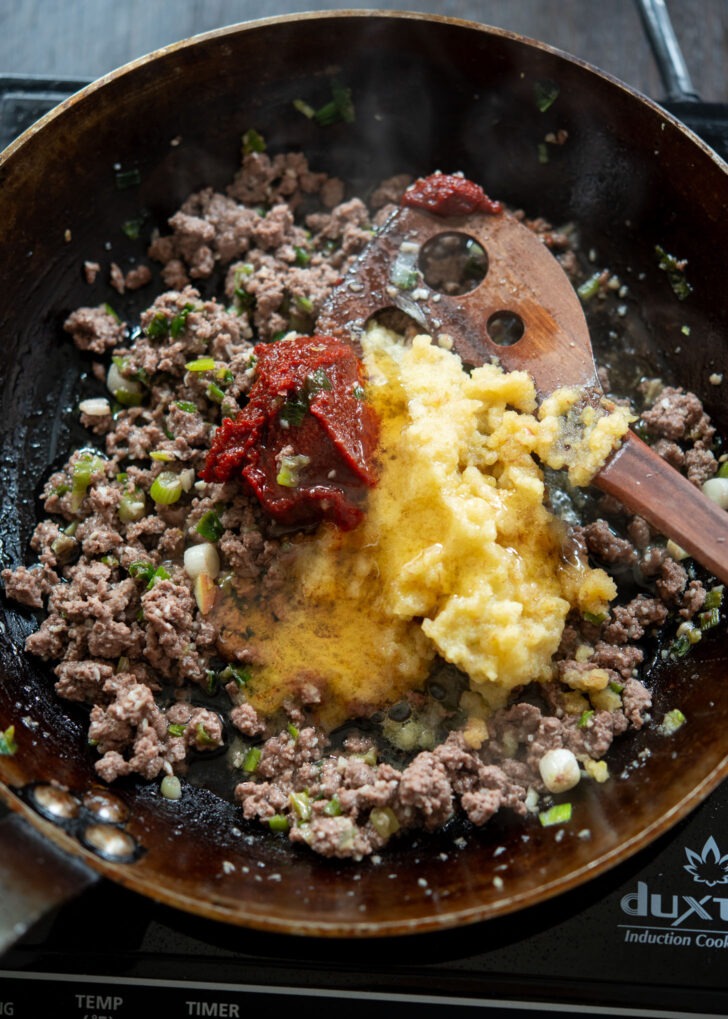
Step 3. Add Apple and Seasonings
- Turn off the heat. Use a fine grater to grate the apple directly over the beef mixture.
- Turn the heat back on, add gochujang, honey, and rice wine; stir to combine. Continue to stir-fry the sauce until it thickens, about 3 minutes.
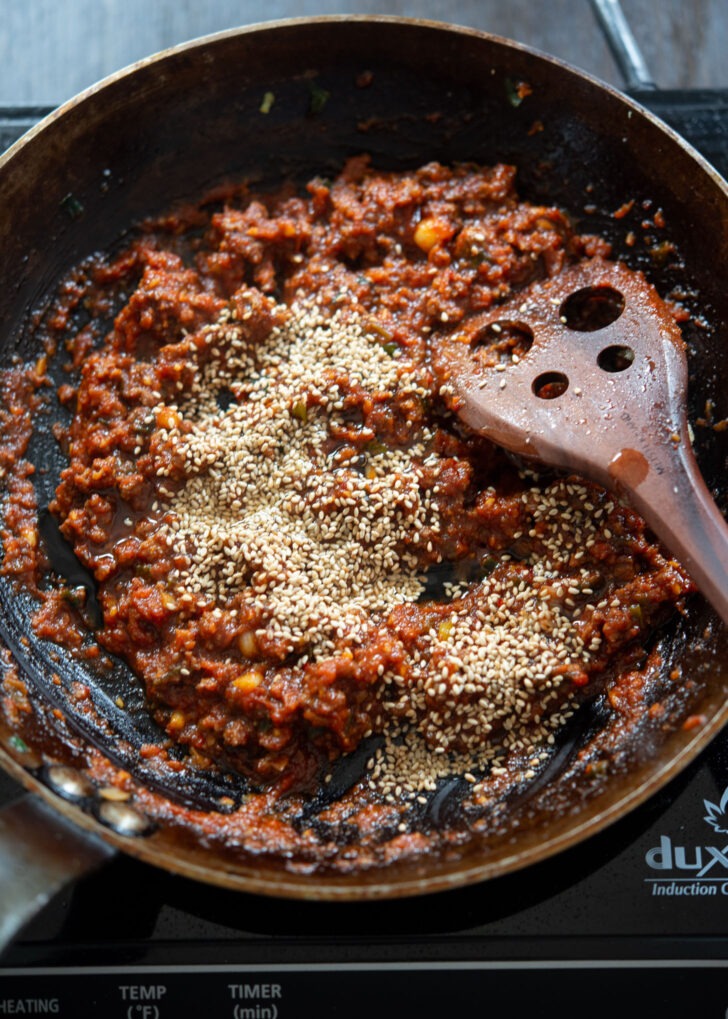
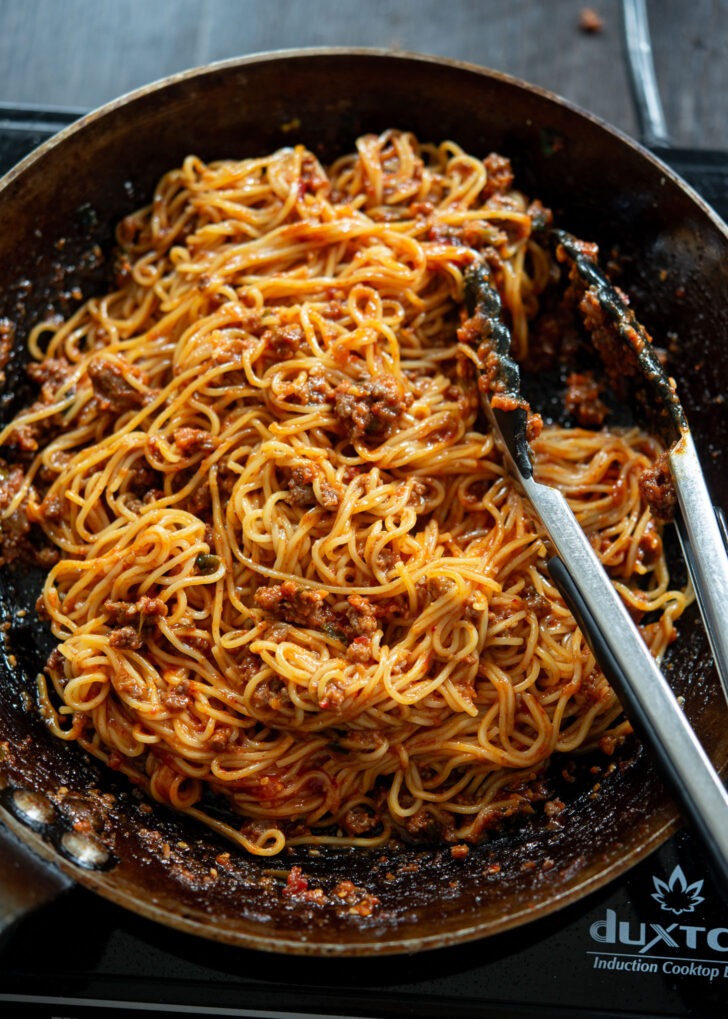
Step 4. Combine Noodles and Sauce
- Drizzle with sesame oil and sprinkle toasted sesame seeds, and stir.
- Add the noodles to the gochujang sauce in a skillet and give everything a good toss to evenly distribute the flavors
Serving Suggestions
It is best to serve gochujang noodles immediately while hot. For serving, place individual portions of noodles in a bowl, top with shredded cucumber, and serve right away.
Storage and Reheating Tips
Store any leftover noodles in an airtight container in the refrigerator for up to 3 days. To reheat, gently warm the noodles in a pan over medium heat, adding a splash of water if necessary to prevent them from drying out.
Alternatively, reheat them in the microwave in 30-second intervals, stirring between each interval.
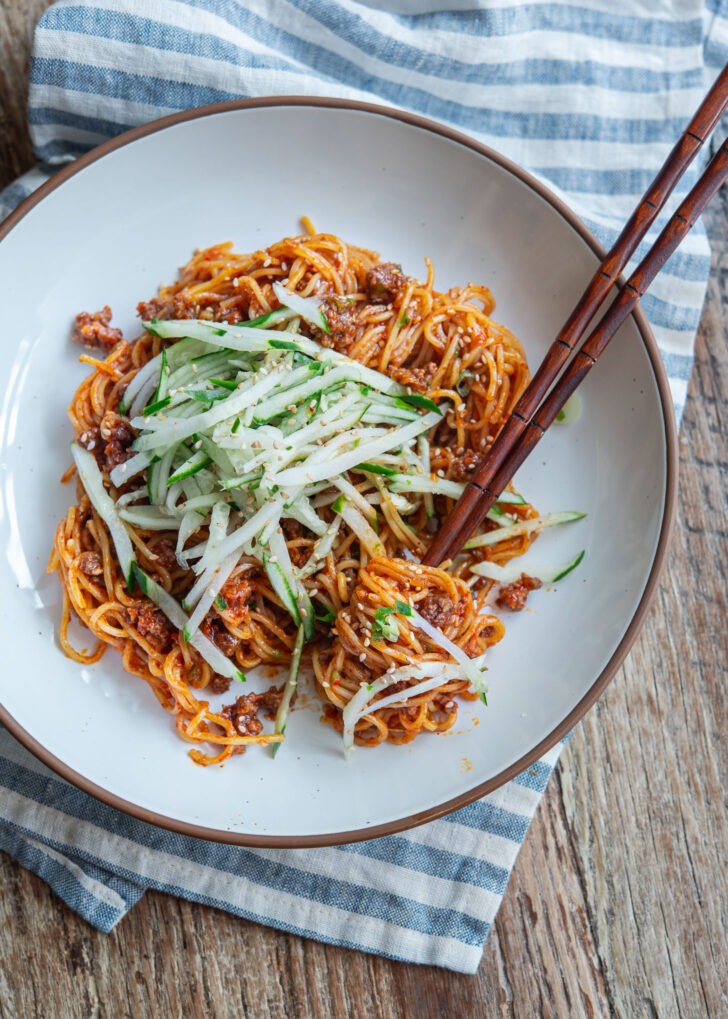
Frequently Asked Questions
Can I Make Gochujang Noodles without Beef?
Absolutely! You can substitute the beef with chicken, pork, tofu, or any plant-based protein of your choice to suit your dietary needs.
Can I Add Veggies to the Sauce?
Yes, adding vegetables like sliced bell peppers, zucchini, and spinach is a great way to boost the nutrition and color of this dish. Simply stir-fry your chosen veggies with the beef before adding the sauce ingredients. Continue with the recipe as directed after the vegetables are tender.
How Can I Make this Recipe Gluten-Free?
To make this recipe gluten-free, use a certified gluten-free gochujang and opt for gluten-free noodles, such as rice noodles.
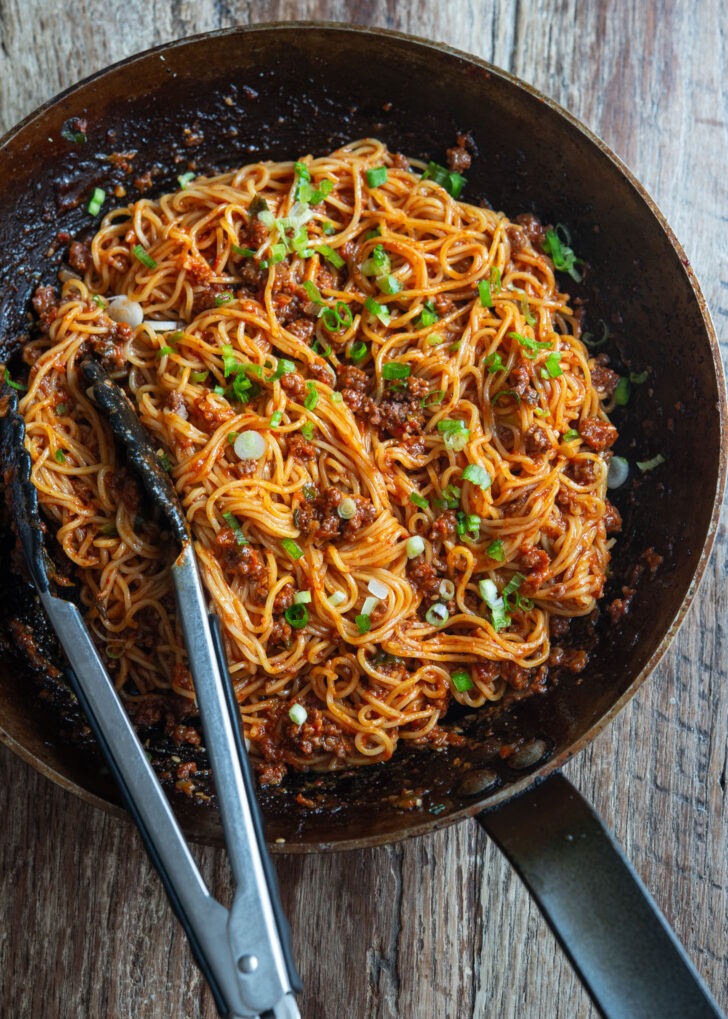
Love this recipe? Rate it and share your experience in the comments below! On Instagram? Tag me to showcase your creation. For more delicious recipes, subscribe to our newsletter!
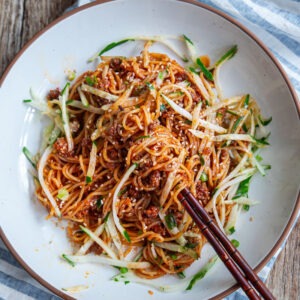
20-Minute Beef Gochujang Noodles
Recipe Video
Ingredients
- 4 servings fresh udon noodles or egg noodles, see note below
- 1 tbsp oil
- 3-4 green onion, chopped
- 1 tbsp minced garlic
- 1/2 lb ground beef, preferably 90% lean. See note for vegetarian or vegan option
- 1/2 small sweet apple, seeded. See note for substitute
- 2-3 tbsp gochujang, see note below
- 1 tbsp honey
- 2 tbsp rice wine, or 1 tbsp rice vinegar
- 1 tbsp sesame oil
- 1 tbsp toasted sesame seeds
- 1 English cucumber, shredded
Instructions
- Prepare the Noodles: Cook your choice of noodles according to the package directions. Drain and set aside.Note: If using fresh wheat noodles (such as ramen noodles), rinse under water to remove extra starch, and coat with a small amount of oil to prevent sticking.
- Prepare the Beef Mixture: In a large skillet, heat oil over medium heat. Add green onion and garlic; stir-fry for 30 seconds. Add ground beef and cook until no longer pink and cooked through.
- Add Apple and Seasonings: Turn off the heat. Use a fine grater to grate the apple directly over the beef mixture. Turn the heat back on, add gochujang, honey, and rice wine; stir to combine. Continue to stir-fry the sauce until it thickens, about 3 minutes.
- Combine Noodles and Sauce: Drizzle with sesame oil and sprinkle toasted sesame seeds. Add the noodles to the skillet and give everything a good toss to evenly distribute the flavors.
- Serve: Place individual portions of noodles in a bowl, top with shredded cucumber, and serve right away. Enjoy!
Notes
- For noodles, fresh options such as udon, egg noodles, or ramen noodles work great. But dried spaghetti will work too. I don’t recommend thin wheat noodles (somen) since they can break easily while tossing with the sauce.
- If reducing the amount of gochujang, add 1-2 tablespoons of soy sauce to compensate for the seasoning.
- To substitute for grated apples, use 1/4 cup of apple juice or pineapple juice.
- For a vegan or vegetarian option, substitute the ground beef with a plant-based protein or simply omit it from the recipe.


Delicious noodles. I love udon. I think one of my favorite parts of Korean cooking is using fruit instead of sugar to compliment the spicy ingredients.
this came out so good! I used 1 tbsp gochujang and 1 tbsp soy sauce, and followed the recipe exactly with ramen noodles! Very sweet, just enough spice. Will make again
Made a double portion of this as it sounded delicious. Not going to lie I changed it up a bit adding half beef half tofu and zucchini cooking in instead of the cucumber on top because I didn’t have that in the fridge. Definitely still a delicious combination! I am going to add this to my staple list of stuff. Gochujang for the win!
Yeah! So happy to hear that you liked it. Tofu and zucchini are great alternatives for this recipe. Sounds delish! Thank you so much.